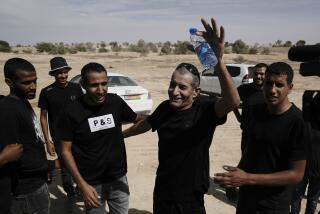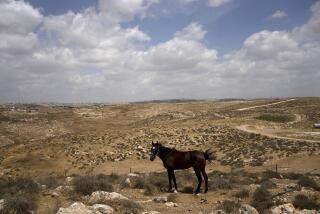Israeli Bedouins Resist Pressure to Pull Up Tent Stakes in the Desert
ARAQIB, Israel — Salim abu Medeghem bent to the parched earth and yanked up a crunchy tuft resembling straw -- all that remained of his wheat crop, he said, after Israeli airplanes sprayed herbicide on the contested parcel.
“This is burned,” he said. “This is all burned.”
Abu Medeghem, 38, vowed to plant again in the fall, even if the Israeli government sent more planes. “This is my land,” he said.
The stubbly field is one front in an increasingly tense struggle over land between the Israeli government and thousands of Bedouin Arabs inhabiting a broad desert swath of southern Israel known as the Negev.
The government insists that the Bedouins, who live in dozens of unsanctioned tent villages without running water or electricity, lack legal title to the land and should move to towns it has set up for them. This village, for example, is known to its inhabitants as Araqib but is unacknowledged by Israel.
But the Bedouins, their semi-nomadic ways long behind them, contend that they have occupied the land for decades, before Israel existed, earning ownership rights they have no intention of ceding. They accuse the Israelis of trying to push them aside to make room for Jewish settlers.
The tug of war has intensified recently as Israel carries out a year-old initiative that combines tactics of persuasion and tough enforcement to relocate the Bedouins.
An estimated 70,000 Bedouins live in 45 “unrecognized villages” that seldom show up on Israeli maps. Some of the communities sit no more than 200 yards from traffic whizzing past on the desert highways.
Many Bedouins still make a living growing crops, herding goats and sheep, and raising camels for milk. But the vast majority now work as low-wage laborers and construction workers. Their boxy black tents, once covered by protective goat hair, today are sheathed in tarps.
The festering land dispute has served to underscore the Bedouins’ peculiar position in Israel, where their health and living conditions are among the worst of any group and charges are frequent that they get short shrift from the government.
But the Bedouins, though tradition-minded Arabs, have nonetheless coexisted with the Jewish state that took root around them. As Israeli citizens, they made a name for themselves in the Israeli military with their tracking skills. Bedouin organizers have sought to capitalize on that record of service in fighting to remain on the disputed land.
Israeli authorities argue that moving the Bedouins into communities sanctioned by the government will bring them into compliance with zoning laws, creating more orderly land use and making it easier for Israel to provide running water and electricity, schools and medical clinics.
“It’s high time for this to take place. It should have been done ages ago,” said Yaakov Katz, who is in charge of administering the Negev Bedouins for the Israel Lands Authority. “The main goal is to make order in this and to make sure the Bedouins get their rights and [fulfill their] duties.”
The Bedouins have fought back with a high-profile campaign, accusing Israel of excessively harsh measures to uproot them, including the aerial spraying, which has made some people ill, and demolitions, which have included at least one small mosque.
For many Bedouins, it is difficult to imagine leaving the villages for the towns Israel set up for them in a previous resettlement campaign that began in the 1960s.
Those established communities -- now with 65,000 Bedouin residents -- are among the poorest in Israel, plagued by substandard housing, unemployment and high educational dropout rates. Many Bedouins prefer to live among their clan members in the bare-bones villages rather than move into one of the towns run by Israel.
Rahat is one of those towns, a few miles up the road from this collection of tents and scrap-wood sheds claimed by 250 members of the Abu Medeghem clan, whose case is before an Israeli court.
“Nothing more than a refugee camp,” scoffed 62-year-old Ismail abu Medeghem, sitting in a spacious tent, its broad sides rolled open to let the desert wind wash through. He and other residents say they will keep fighting to stay.
Bedouin activists say it is the government’s duty to bring services to the villages, which they say were left off the grid by a 1965 land-planning law that ignored them. As a result, there are only about eight medical clinics among the 45 far-flung villages.
In villages such as Araqib, on the scrubby outskirts of Beersheba, the regional capital, it will be up to the courts to settle who is the rightful landholder.
Resolving ownership in this region is not easy.
Some families, including that of Salim abu Medeghem, base their claims on papers they say date to the Ottoman Empire; others rely on tradition alone. Many Bedouins say they ceded their lands to the new Israeli state in the 1950s for military use, but only temporarily.
The current battle is over a shrunken pie. According to the government, nearly three-fourths of the Negev region, or about 2.3 million acres, is set aside for military use. About 35,000 of the remaining acres are leased to Bedouins for farming, including land around the villages. But as many as 125,000 acres are ensnared in court disputes or deemed by Israel to be improperly occupied.
Israel’s government considers the Bedouins to be squatters on state land.
The land conflict has simmered for years, but it has flared since the government of Prime Minister Ariel Sharon last year announced a five-year, $250-million effort to resolve the issue.
The campaign seeks to relocate Bedouins to the seven established towns or to a few of the largest Bedouin villages being upgraded with schools, health clinics and running water.
“The Bedouins will assume responsibility for their future. They will elect their representatives. They will get all the services that citizens get in the country and be able to take part. They will enjoy much greater equality with the other citizens who live in the area,” said Katz of the land authority.
As part of the push, Israeli authorities allotted about $10 million to the court system to help it sort out the land cases and $75 million for compensating families that are uprooted.
The government also has cracked down by sending police and demolition crews to take down dozens of new buildings, in addition to spraying the fields it says should not have been planted.
So far this year, Israel said, it has sprayed about 900 acres -- a controversial tactic that officials view as less prone to violent confrontation than expulsion. (In March, Israel’s Supreme Court issued a temporary halt to the spraying policy after human rights groups filed suit. The government says the spraying was done safely and with warning.)
The Bedouins and their backers charge that the enforcement measures amount to a heavy-handed push to clear them out and make room for an expanded Jewish presence in the Negev. One of the government’s newly approved settlements, consisting of mobile homes, appeared overnight in January on property claimed by Araqib.
In addition, Israel has promoted a new real estate development, known as private farms, under which families set up small homesteads on tracts the government supplies with water and other utilities. Bedouin villagers see these as another type of settlement.
Each year, more subdivisions sprout in the Negev, which recently has been mentioned as a possible site for relocating the 7,500 people who would be withdrawn from the Gaza Strip under Sharon’s proposal to evacuate all 21 Jewish settlements there.
In the meantime, the skirmishing continues.
In a community called Azarura, Bedouin resistance to the government plan is evident in the concrete blocks stacked near the village entrance.
The blocks will be used to replace a building that Israeli authorities bulldozed in January after winning their argument in court that the structure was erected without a permit. Bedouin villagers say the building was a mosque, but Israeli officials say it was an illegal dwelling. In any case, the disputed structure is now a pile of debris with a flimsy sheet-metal minaret lying on top.
Under a pale yellow tent that serves as a kind of meeting hall, Sheik Suleiman abu Ajaj, 75, fingered prayer beads and recalled the way life used to be for the Negev Bedouins, when shepherds and their goats moved back and forth between the desert and the Dead Sea, according to the seasonal rhythms.
Camels were the favored means of travel then, but no more. As he spoke, big-rig trucks roared past on the highway, less than a football field away from his tent.
Abu Ajaj said it would cost about $40,000 to replace the demolished building -- no minor sum in a village of dirt streets. When asked what the Bedouin villagers would do if the new building met the same fate as the last, he did not hesitate.
“We will rebuild it again,” he said.
More to Read
Sign up for Essential California
The most important California stories and recommendations in your inbox every morning.
You may occasionally receive promotional content from the Los Angeles Times.










